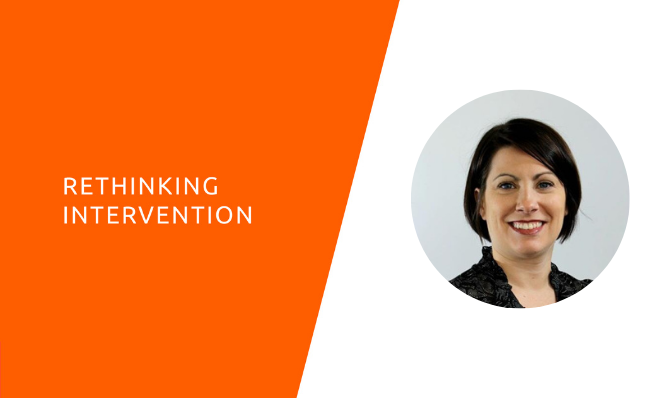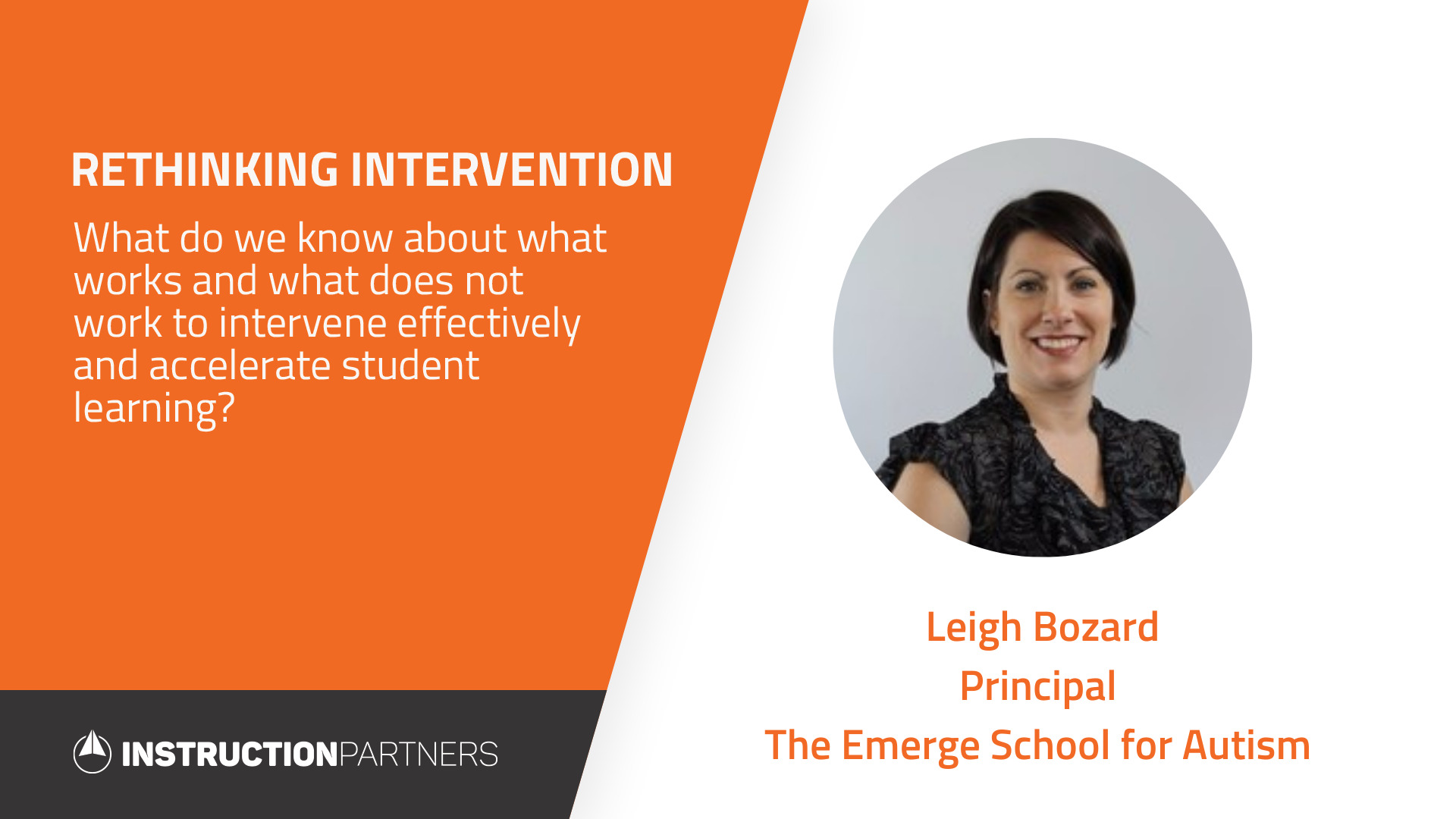
Leigh Bozard, Emerge School for Autism
Leigh Bozard is the principal of the Emerge School for Autism in Baton Rouge, Louisiana. The Emerge School for Autism educates students with Autism Spectrum Disorder using therapeutically focused, evidence-based strategies grounded in the principles of Applied Behavior Analysis and Universal Design for Learning, enabling children to reach their full potential and transform their lives.
Elizabeth Ramsey, Senior Managing Director of Program at Instruction Partners, spoke to Leigh about the challenges educators are anticipating when returning to school this fall. This conversation took place on June 3, 2020.

ER: Please start us off with a personal story of a student that really informs your perspective about the work of helping students accelerate learning.
LB: Years ago, I taught a small kindergarten class that consisted of all students with autism and special needs. We had one student with autism for whom the interventions we were doing weren’t really effective. The data wasn’t moving. We were looking at it from trying to figure out what the perspective was, but there were a variety of issues. It wasn’t just the data on the paper. When you walked in this classroom, sometimes you would see this child try to climb the walls like Spider-Man and leap off of them, and then sometimes you would see him roll himself up into my circle time carpet like a burrito. This was all part of what made up this child and who he was. Our occupational therapist came in and saw that and she said “we really need to be spinning him, I’ll put together a protocol for you to implement and follow with my guidance, but he needs vestibular input that he’s not getting.” With the protocol she put into place, he was able to sit at the table and do the interventions and do the academic work, whereas he wasn’t before. Just looking at straight data on paper doesn’t give you the full picture. We have a phrase that the world of autism uses that “If you’ve met one child with autism, you’ve met one child with autism.” That’s true for children in general. Children are all unique individuals and we really need to look at the bigger picture and the whole child to see what they need.
ER: We are certainly in a unique circumstance nationally right now as we head into school this fall. What challenges should teachers be prepared for when students return to learning in the fall?
LB: I think the obvious is potential learning gaps. Regardless of how robust a school’s distance learning program was, many children still required the parents or adults in their household to help them. If they didn’t have that, they just didn’t have that. Also, parents are not educators. Keeping that in mind is important, particularly for students with special needs and students in K-2. Students in K-2 and students with special needs very often need an educational program and model that can be very hands-on that can be very kinesthetic. These distance learning programs that we put together this spring don’t offer that a lot. So we need to be very mindful when we’re thinking about that.
ER: I’ve heard some schools talking about figuring out how many students will be able to be in the building with social distancing. A lot of schools are thinking about prioritizing bringing back their K-2 students and their special education students to make sure that those groups of students get in-person learning time.
Thinking about the learning needs that you’re talking about, very frequently we use intervention as a solution for this in education. I would love to hear what you have seen works in intervention and what you would hope to see school system leaders prioritize in their response.
LB: The short answer to that is very specific innovative interventions based on students’ needs. In the example I gave before, the data isn’t just the only answer. One size fits all interventions aren’t successful for students in schools. Because one size doesn’t fit all. The data may show that these four children all have similar challenges, but then when you step back and you talk to that child’s teacher about what this looks like in the classroom, the reasons behind it can be very different and that will change the interventions that you choose for that student. At our school, every student has an Individualized Education Program. I think that in intervention we need to move toward very individualized interventions for students based on their specific needs.
ER: When you talk about finding the bigger picture, what are some of the ways that you form that bigger picture for yourself?
LB: Asking the questions, what does this look like in the classroom? Where does the child sit? How do they act when given this intervention? How do they act when they’re frustrated? What does this look like when the child has given up? What happens to lead up to all of those? The puzzle piece is used in autism as a symbol because autism is very complex and can look very different in very different children. If we think about intervention more in that way, we’ll find more success. Do we have enough pieces of the puzzle? Have we searched for those pieces of the puzzle to look to where we can? We may not have all of them, but enough that we can see the picture behind what’s going on.
ER: I’m hearing so much in your response about the whole child, how they respond to the world around them, how each child is unique. How should educators be thinking about that during this time knowing that we’ve been in crisis, especially for students who have experienced trauma?
LB: It’s cliche to say, but it’s unprecedented. The levels of trauma that children are going to experience are going to be different and are going to present in different ways. I think that some of it will present as academic challenges and some of it will certainly present as behavioral. Some of it will present as they’re regressing emotionally and/or psychologically. I think it’s keeping that in your mind always. Could trauma be part of this thing? Keeping that perspective is important.
ER: What have you seen not work in intervention that you hope that folks avoid this fall?
LB: One, I’ve seen is where educators get really excited, and leaders get really excited because they see this one intervention that they test-piloted with a handful of kids and it worked. Then they apply it all the way across the board because this is going to be our answer. And again, there’s no special sauce. It’s not one size fits all, and there’s no secret intervention that’s going to be your solution. Two, I’ve seen a lot of school leaders choose interventions as their Tier 1 curriculum. I think it’s really important that we keep in mind that you’re not exposing children to grade-level text and grade-level material and challenging them in that way. Just because a child has significant needs doesn’t mean that you cannot expose them to grade-level text. Yes, it’s hard. Yes, you need to provide scaffolding Yes, you need to help them work through it, but you’ve got to expose them to it.
ER: Anything else that you would want to impart to teachers and leaders as they head into the fall?
LB: I really hope leaders beyond me and the other school leaders–I’m thinking more leaders in legislation and governors—think really hard about bringing children back in the fall. Specifically, who needs to be brought back and who can participate in distance learning. I feel strongly that students with significant special needs need to be in a classroom, in smaller classroom settings and given restrictions and guidelines so that we keep everybody safe. If we really want learning to happen, we need to be here. I think the same is true for K–2. Those need to be in-person experiences and we need to modify what we’re doing so that we can bring in those students. Then for students that are capable and are able to do distance learning, we can modify for them as well.
ER: Thank you so much for sharing your perspective today. It was so great to learn from you.


